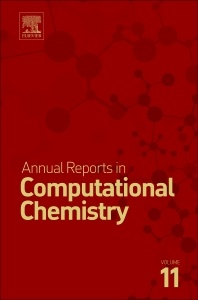Description
Annual Reports in Computational Chemistry
Annual Reports in Computational Chemistry Series
Director of collection: Dixon David A.
Language: English
Subjects for Annual Reports in Computational Chemistry:
Keywords
Ab-initio theory; B80; Boron buckyball; Boron clusters; Boron fullerenes; Boron volleyball; Complex networks; Computational approaches to scattering in many-body systems; Density functional theory; DFT-NL; Dispersion corrections; Electron paramagnetism; Electron spectroscopy; Electronic absorption spectra; Epikernel principle; Excited charge propagation dynamics; Fukui functions; Graph theory; Hydrogen bonding; Hyperfine coupling; β-Decay; Intermolecular interactions; Leapfrog principle; Molecule-laser interaction; NMR shifts; Nonlocal density correlation kernels; Percolation theory; Real-time; time-dependent density functional theory; Relativistic effects; Resonant multichannel scattering theory; Ring current; Time-dependent Schrödinger equation; Ultracold Fermi gases; van der Waals interactions; VV10; Weakly bound molecular complexes
Support: Print on demand
Description
/li>Contents
/li>Readership
/li>Biography
/li>Comment
/li>
Annual Reports in Computational Chemistry provides timely and critical reviews of important topics in computational chemistry as applied to all chemical disciplines. Topics covered include quantum chemistry, molecular mechanics, force fields, chemical education, and applications in academic and industrial settings. Focusing on the most recent literature and advances in the field, each article covers a specific topic of importance to computational chemists.
Quantum Chemistry (Section A)
- NMR Calculations for Paramagnetic Molecules and Metal Complexes
- The Nonlocal Correlation Density Functional VV10: a Successful Attempt to Accurately Capture Noncovalent Interactions
- Modeling Laser Induced Molecule Excitations Using Real-Time Time-Dependent Density Functional Theory
- Chemical Bonding, Reactivity and Viability of Large Boron Clusters
- A Computational Perspective on Multichannel Scattering Theory with Applications to Physical and Nuclear Chemistry
- Intermolecular Network Theory: A General Approach for Understanding the Structural and Dynamic Properties of Liquids and Solutions Aurora E. Clark
Jochen Autschbach
Joaquín Calbo, Enrique Ortí, Juan C. Sancho-García and Juan Aragó
Attila Bende
Jules Tshishimbi Muya, Minh Tho Nguyen and Arnout Ceulemans
Scattering Theory (Section B)
Simone Taioli and Stefano Simonucci
Theory of Liquids (Section C)
- Quantum chemistry
- Molecular mechanics
- Force fields
- Chemical education and applications in academic and industrial settings




